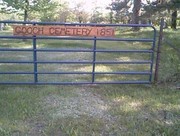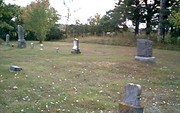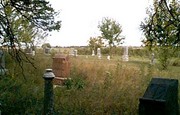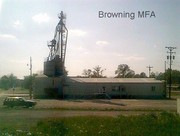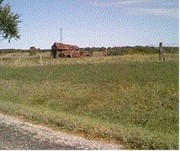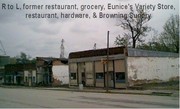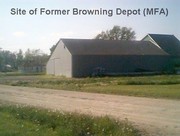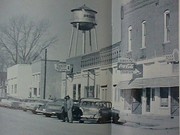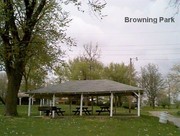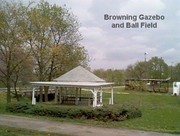Browning History
Gooch Cemetery
As late as the 1950's, if you were a Republican, and you planned to be buried in the Gooch Cemetery, you had only one choice: Be buried on the republican side! Democrat? You'd be buried on the democrat side!
In 1841 two brothers named William Greenup Gooch and Thomas Shelton Gooch settled on farms approximately two miles north of the Linn R-1 School. (The property is currently (1997) owned by Mr. Tully Reed.) They had moved from Greenup County Virginia. Both had large families and large land holdings (approximately 3000 acres in Linn County).
When the Civil War broke out, the brothers had a disagreement over various issued including slavery. Thomas was pro-Union (Republican) and William was pro-Confederacy (Democrat). Before the war, they had jointly owned the Gooch Cemetery for family burials. However, the division between the brothers was so deeply rooted that members of each family were buried on their respective Democratic or Republican sides of the cemetery with a large grassy patch dividing the two.
William was the first to die (1893). Thomas refused to go over to the Democratic side of the cemetery for the funeral. He reportedly stated that he could pay his respects just fine while standing on the Republican side. As late as the 1950's, descendents were still being buried on the respective sides.
When the photos were taken for this web site, one side was mowed and nicely trimmed, and the other side was in dire need of attention. What can be said?
Footnote: William owned slaves and there was a slave cemetery west of the main cemetery. Some say William taught his slaves to read and write, which was against the law after 1847 in Missouri. William was Rick Thurlo's great-great-grandfather, the 16th child, by his fourth wife.
Railroad History
The Burlington Railroad first began service to Browning, Missouri, in 1872. The town grew quickly after the railroad arrived and had around 1,000 people in the early 1900's. The depot was located in the southern part of town near the present MFA plant food building (the one in the city limits). The big depot looked much like the one in Linneus. It was torn down in the mid-1950's and some of the lumber was used in Jeff and Robin Morelock's present home. Rail service was discontinued in 1981, and the track was removed in 1982.
In the late 1930's, the Burlington Railroad discontinued regular passenger trains on the line that ran through Linneus, Purdin, and Browning. The regular locomotive passenger trains were replaced by a self-contained unit known as the "Doodle-Bug" or "Puddle-Jumper." It contained a power section and a passenger section, plus a small freight department. Mail was carried for many years in the freight section.
The unit was powered by a gasoline burning engine. Twenty-five to forty passengers could be accommodated. The "Doodle-Bug" was used on the route until about 1951 or 1952. During most of this time, there was one "Doodle-Bug" each way each day. They traveled at high speeds, probably 50 miles per hour or faster, and were equipped with a whistle-like device that could be heard from a long distance.
At times, the "Puddle-Jumper" would break down and had to be pulled up and down the track with a steam locomotive. It was an interesting sight to see the "Puddle-Jumper" being pulled by a steam locomotive.
Sample rates: Browning to Purdin--$.26; Browning to Laclede--$.70; Browning to Cora--$.22; Browning to Unionville--$1.25; Browning to Linneus--$.45; Browning to Brookfield--$.88. These charges were raised or lowered over the years, depending on economic conditions.
Scottsville
Not much is left of the town of Scottsville, but it was once the second largest settlement in Sullivan County, next to Milan. It is the second oldest settlement in Sullivan County. Scottsville was located approximately six miles NW of Browning and was first settled in 1836, even before Linneus. At one time, there were 300-400 people who lived there, and it had two general stores, one drugstore, one hotel, one saw and grist mill, two blacksmith shops and one church.
The first merchant in Scottsville was Washington Weathers (1847). One of the early settlers was the great-great-grandfather of Rick Thurlo, John Thurlo.
Located between two creeks, East Locust and West Locust, Scottsville was thought to be a good choice of land. (See Map in slide show) It thrived until the railroad came to Browning, then it quickly declined as people moved to be near the railroad (late 1880's).
During the Civil War, there was a Union camp at Laredo and people would come to the tavern in Scottsville. One story is that once they were there, soldiers would harass local farmers by telling them to yell for Lincoln or else they would beat them up! Bushwhackers for both the Union and the confederacy roamed this area during the Civil War, terrorizing people of both convictions.
Around 1900, Scottsville's doctor, Dr. Whaley, tore down his brick house and rebuilt it in Browning. It was located in SE Browning. Today, all that is left of Scottsville is a tree that stood near the old school and a garage.
Early History of Browning
The land that is now Browning was first purchased by a man named Francis Stone on October 30, 1840. The land passed through various hands until it was officially platted on November 15, 1872. It was 50 acres, partially in Linn County, partially in Sullivan County. In 1892 it became a fourth class city.
Browning was named for a Mrs. Browning of Burlington, Iowa, by Justin Clark, a member of the Burlington & Southwestern Railroad company. Mrs. Browning was the wife of a brother of John O. H. Browning. The first electricity was approved and put into effect on June 21, 1915. The streets of Browning were graveled by approval of the city council in 1929. In 1956 city water was installed.
In 1873, Browning had one general store, one blacksmith shop, one saloon, and a post-office. The first house was built by John Gable as a residence for B. F. Northcott. The first school in Browning was taught in the spring or summer of 1874 by W. T. Wogan. The first marriage was in 1873: N. O. Beacham and Matilda Smith. The first schoolhouse built, of any value, was in 1881, having a cupola and bell; the cost when completed was $600.
In the late 1880's Browning was the second largest railroad shipping town in Linn County, next to Brookfield, with logs, lumber and hoop-poles being the main items shipped. Coal was mined locally, though not commercially.
Legend and Lore
In addition to the Meeks Murder Case, another
infamous murder case also took place near Browning and is known as
the Calhoun Murder of the Civil War. This incident occurred
several years before the founding of Browning. It was a part
of Browning discussion for many years, partly because several of
the victim's children lived in the area; in fact, one daughter
lived well past her 90th year and was in good health until the end
of her life. She spoke often of the incident.
In 1864 there were many incidents in our part of
the state, known as bushwhacking. Bushwhacking is usually
defined as illegal activities like robbery and murder being
committed by those not in the military. Because of the
general confusion resulting from the war, the bushwhackers hope to
escape capture, and perhaps their actions will just be considered
part of the war and blamed on the other side.
In the summer of 1864, the commander of the Union
Army post at Milan, Lt. Sterling accompanied a large group of
soldiers to the Calhoun farm west of Browning. They had
been called to the area to investigate reports of bushwhacking.
William Calhoun was a well-known, highly respected
citizen. He resided on the farm where the Rehbein family now
resides. He owned property on both the Linn and Sullivan
sides of the country line. He was probably the largest
landowner in our area at that time. As far as most people
know, Mr. Calhoun nor any of his family had taken sides in the
war.
Lt. Sterling asked Mr. Calhoun to guide the
soldiers across a field and help them find the road on the other
side. This seemed to be a very safe request, but as they were
crossing the field, shots rang out and Mr. Calhoun fell dead.
The discussion has always revolved around the question: Who
killed William Calhoun? The most common theory speculates
that some of his neighbors were involved. The neighbors were
at least sympathetic to the bushwackers, and probably also to the
Confederate cause, and, therefore, shot Mr. Calhoun for his
apparent cooperation with the Union soldiers. As his tombstone
indicates, his family classified his death as murder. It is
located in the Calhoun/Phillips Cemetery, west of Browning and a
little south, in Linn County.
It was several years after the end of the war
before any arrest was ever made. A neighbor, James Head, was
arrested for the murder, but, unfortunately, Mr. Head never came to
trial because of a broken leg he received while in jail. Soon
after the broken leg, Mr. Head passed away. Officially, Mr.
Head never confessed.
The most often discussed theory indicates Mr.
Head was probably not the guilty party, but that he did probably
know what actually did happen and knew who was actually
involved.
In regards, to Mr. Calhoun's daughter that lived
past her 90th year? Well, she always blamed the Union
army, perhaps, not for the actual killing, but at least for getting
her father in such an awkward position. She was known to use
the term "damn Yankees" often. In later years, it was almost
impossible task, but her grandsons to found out that her
husband had been in the Union army. She was unmarried
at the time of her father's murder. The grandsons were
convinced that her husband had done his best to hide the fact that
he had served in the Union army.
To pinpoint the location a little more
accurately, the Calhoun murder occurred about 4 miles straight west
of Browning. As I mentioned earlier, the Rehbein family now
owns the land where the Calhoun home was located. Presently,
the area all around the Locust Valley Cemetery and the site of the
former Locust Valley Baptist Church would be in about the middle of
the Calhoun farm.
Browning in 1998
In the slide show you will find a
picture of the downtown area of Browning as it appeared in April
1998, the community's 126th year. As you can probably see,
the business district has greatly declined. There are only
ten businesses open in town, and only about half of these are on
Main Street. Some of these that are open are only open
part-time.
On the brighter side, Bank Midwest employs two
full-time workers, plus several others from the other Bank Midwest
locations. They have considerable business. The
Browning MFA Exchange employs five full-time workers and some
part-time workers. It did about $2.3 million worth of
business last year.
Browning was a thriving community full of
commerce and trade for many years. The population and
business district grew rapidly from the coming of the railroad and
the founding of the town in 1872. By 1900 the business
district stretched all the way down Main Street from the Baptist
Church on the west to the railroad tracks, just east of the present
MFA. The depot was located on what is now the MFA property.
There were businesses on both sides of Main Street and
even around one block to the South. The Browning population
peaked at over 1,000 in the 1900 census.
The biggest business and employer in the early
days was the Jenkins Hay Rake and Stacker Factory, which was
located on the north side of Main Street west of the railroad
track. The former Hooker Chevrolet building and property is
almost exactly on the site. It is on the northwest side of
the main intersection in Browning today. The factory opened in 1890
and moved to Chillicothe in 1907. The factory produced hay
rakes, hay stackers and cast iron door stops. The
factory used steam power and moved to Chillicothe because
electricity was available there. The factory usually employed
about 150 men. In 1997, I attended an auction where a cast
iron rabbit made at the Jenkins foundry sold for $250, and a cast
iron frog sold for $175.00Despite the loss of the hay rake factory,
the local farming economy kept the community thriving for many more
years.
A tremendous fire in November 1928 destroyed at
least six businesses on the south side of the middle block of Main
Street. Most of these businesses quickly reopened and most of
the buildings were rebuilt; however, some were never replaced.
Many times I have heard the expression "Browning
never recovered from the Great Depression!" This is probably
true, but Browning wasn't the only place that suffered such a fate.
At the beginning of the Depression, Browning had three banks
and most of the businesses from the Baptist Church to the railroad
were open. One bank closed and the other two combined
and the business district was hit hard. Many businesses
were closed by Pearl Harbor in 1941 and never did reopen.
Despite the downturn, the population was 686 in
1940. After World War II, many people returned home and then
left the farm for someplace else. The 1950 population was
492, and the business district was beginning to show many vacant
buildings. The 1960 population was 411; 1970 was 360; 1980
was 368; 1990 was 311. (The high point was a census of over
1,000 in 1900.)
The steady decline in business continued through
the '50's, '60's, '70's and then in the mid to late 1980's almost
everything disappeared. In the 1960's several businesses were still
in operation in downtown Browning. The only grocery store
closed in 1986 and the Chevrolet car dealership, a couple of years
later. We went from four to one service station and
very little other business. The bank moved from Main Street
to Highway 5. Cordray's Center suffered a fire on Main Street
and also moved to Highway 5. The school left with the
building of the new school in Purdin and the railroad was
abandoned, both in 1981.
Browning MFA
The Browning MFA is a business success story
despite several trying times. The business was founded as the
Browning Farm Club in 1920. The original business rented a
building just east of the present Browning Baptist Church.
Later, they moved to the present Altes Garage building
on the north side of Main Street. They remained there from
1925 until moving to the present building in 1965.
In February 1975, a fire did much damage to the
present building, but all was rebuilt. In October 1991 a wind
storm destroyed most of the business's small grain bins and did
much damage to the main building. However, everything was
back to normal in about six weeks.
The loss of the railroad and the Conservation
Reserve Program have cut down considerably on the among of grain
and soybeans the local MFA handles. The elevators on the
railroad pay higher prices and since most local farmers have
trucks, they head to the railroad elevators. The CRP has
taken lots of local soybean and grain land out of production.



